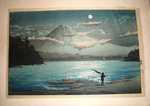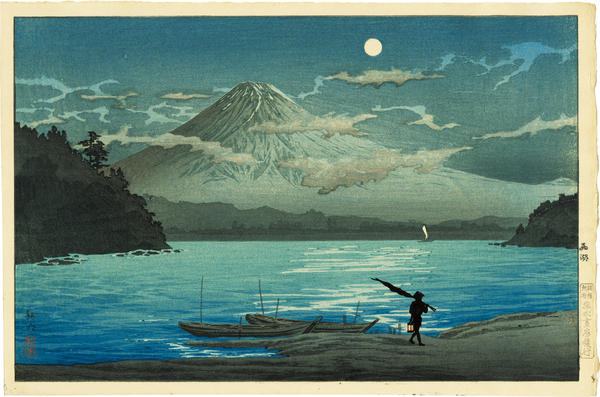| | |
| Artist: | Shotei Takahashi (1871-1945) Hiroaki — 松亭高橋、弘明 |
| Title: | Fuji From Lake Sai — 西湖 |
| Series: | Four Seasons of Mt Fuji — 四季乃富士 |
| Date of first edition?: | 1929-1932 |
| Publisher (first edition)?: | Fusui Gabo |
| Publisher (this edition)?: | Fusui Gabo |
| Medium (first edition): | Woodblock |
| Medium (this edition): | Woodblock |
| Format (first edition): | Oban
|
| Format (this edition): | Oban |
| DB artwork code: | 47705 |
| Notes (first edition)?: |
|
| Notes (this edition)?: |
| The following information was taken from the original web listing of this artwork. Note that there may be some inaccuracies:
TAKAHASHI Shotei / Lake Sai-Ko
Date : 1929 - 32
Size : O-ban
Impression : Very good
Condition : Very good
Detail : Published by Fusuigabo
From the "Fuji in the Four Seasons" series, published by Fusuigabo, depicting the majestic Fuji. The depiction of the mountain surface is remarkable.
When Watanabe Shozaburo established his publishing company, firstly he asked Takahashi Shotei to create a design for Shinhanga, the new wave of Ukiyo-e. These prints became massively popular overseas, and the benefit became a foundation of creating the later well-known Shinhanga prints.
They had created more than 500 Shinhanga works until the great "Kanto" earthquake disaster in 1923. The terrible fires burned out all printing blocks, however, they recreated them with their passions, elaborately.
作品
年代 : 昭和4 - 7年
サイズ : 大判
刷 : 優良
保存 : 優良
詳細 : 孚水画房版
ディレクターコメント
堂々とした富士が描かれた孚水画房版『四季乃富士』シリーズより。山肌の描写は目を見張るものがある。
昭和に入ると新版画は渡邊版画店以外からの版元からも出版されるようになる。孚水画房もそのような版元の1社で、主に海外への輸出用として制作された。
孚水版の版木は太平洋戦争中に全て焼失したこともあり、作品の現存数が少なく希少である。
渡辺庄三郎は独立開業すると、松亭に作画を依頼して「新作版画」を制作した。松亭の新作版画は海外で人気を獲得して、継続してよく売れたようである。これらが基盤となり新版画が制作されるに至った。
大正12年の関東大震災までに大小合わせて500点以上の版画を制作したが、版木も版画も全て焼失してしまったため、それらは震災の後、改めて入念に制作された。 |
|
| Series Information: |
| A vary rare series published by Fusui Gabo. |
|
| Artist Bio: |
Takahashi Shotei was born in Tokyo with the given name of Takahashi Katsutaro. At a young age he was trained in Nihon-ga , the traditional Japanese painting style by his uncle Matsumoto Fuko, and beginning around 1907 Shotei started designing for the Watanabe Color Print Company. Shotei was among the first designers to be recruited into Watanabe's stable of artists, which would later expand to include Goyo, Shinsui, Hasui, Kasamatsu, Koson and Koitsu among others. Many Watanabe prints were designed for export, primarily to North America, where the demand for all things Japanese was high in the early 20th century.
By 1923 Shotei had produced nearly 500 designs for Watanabe, when Tokyo was hit by the Great Kanto earthquake -- the worst recorded natural catastrophe in the history of Japan. The fires ignited by the earthquake raged for three days, and Watanabe's print shop and all the woodblocks created by Shotei and the other early shin hanga artists, were destroyed.
After the earthquake Shotei created another 250 prints mostly depicting scenic Japanese landscapes in the shin hanga style he had helped to define. He continued to work for Watanabe, but also worked with the publishers Fusui Gabo and Shobido Tanaka, where he had more control over the finished print than was possible with Watanabe.
Shotei used a variety of names, signatures and seals during his lifetime. From 1907 until 1922 he used the name Shotei, and after 1922 Hiroaki and Komei.
|
|






